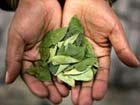| Videos | • Latest |
|
• Feature | • Sports | • Your Videos |
Coca leaf debate in Peru

The coca leaf is the source of the addictive narcotic - cocaine, leading many to call for the plant to be outlawed. Yet many Peruvians and other peoples of the Andes mountains argue that the leaf's nutritional and medicinal properties make it worth protecting.
It is a hard to believe that a plant could be at the center of such a heated international debate.But for more than half a century, the coca plant has been passionately argued for and against by many around the world. In 1961 The United Nation's Single Convention on Narcotic Drugs listed the coca leaf as an illegal substance along with cocaine and heroin. Those countries that signed the convention were obligated to ban coca leaf chewing because of a study published years before that said it only had negative effects a statement that some vehemently argue against.
Baldomero CÁceres, Social Psychologist, said, "I discovered that all the medical studies were given lesser value or ignored altogether by the UN when it did its study on the plant 50 years ago. Which shows the fragility of this supposed study on the coca plant. Now the coca plant is regaining its value even the higher classes consume coca flour. The coca plant is considered less a drug and now seen for its nutritional and medicinal value."
Coca is the plant from which the addictive drug cocaine is derived. According to science Cocaine is just one of the many alkaloids found in the coca leaf and accounts for only 1% of the leaf. Those who argue in favor of coca believe the plant has too many positive uses to be considered illegal.
Angelica Cortez, Coca Farmer, said, "The coca is medicinal it is not a drug. It is for illnesses. If you suffer from Rheumatism, menopause, or pains in your bones, that is what we use it for."
Coca has been used for thousands of years as a mild stimulant and is deeply rooted in the culture of Boliva, Peru and in some areas of Argentina, Chile and Colombia.
Anthony Henman, Anthropologist, said, "It tends to be associated with a work context and ritual context. The 80% that remains is used as a functional stimulant and is therefore associated with agricultural work, or working the mines, or increasingly now in Lima with intellectual work."
CCTV met with farmers in Peru that not only chewed the leaf for energy during long hours of work in the fields, but also practiced reading the coca leaf, a ritual passed on by their ancestors.
"She is asking coca mama a question in her life, and when she eats the leaf, she is going to get an answer. If the leaf is sour or bitter tasting then it is a negative and she should not proceed with anything she is asking. If the taste is sweet it is a positive response to her question."
For years now Bolivia, Peru and Venezuela have been fighting the international opposition to the coca-leaf arguing for its traditional uses. However, it has been an uphill battle, as many governments do not discern between coca leaf growing for traditional use and production of cocaine.
 0
0 







Go to Forum >>0 Comments